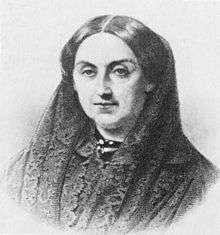Fernán Caballero
| Fernán Caballero | |
|---|---|
 | |
| Native name | Cecilia Francisca Josefa Böhl de Faber |
| Born |
24 December 1796 Morges, Vaud |
| Died | 7 April 1877 (aged 80) |
| Language | Spanish |
| Nationality | Spanish |
| Genre | Novel |
Fernán Caballero (24 December 1796, Morges, Vaud – 7 April 1877) was the pseudonym adopted from the name of a village in the province of Ciudad Real by the Spanish novelist Cecilia Francisca Josefa Böhl de Faber.
Life
Born at Morges in Switzerland, she was the daughter of Johann Nikolaus Böhl von Faber, a Hamburg merchant, who lived long in Spain, married a native of Cádiz, and is creditably known to students of Spanish literature as the editor of the Floresta de rimas antiguas castellanas (1821–1825), and the Teatro español anterior a Lope de Vega (1832). Educated principally at Hamburg, she visited Spain in 1815, and in 1816 married Antonio Planells y Bardaxi, an infantry captain of bad character. In the following year Planells was killed in action, and in 1822 the young widow married Francisco Ruiz del Arco, Marqués de Arco Hermoso, an officer in one of the Spanish household regiments.[1]
Upon the death of Arco Hermoso in 1835, the marquesa found herself in straitened circumstances, and in less than two years she married Antonio Arrom de Ayala, a man considerably her junior. Arrom was appointed consul in Australia, engaged in business enterprises and made money; but unfortunate speculations drove him to commit suicide in 1859. Ten years earlier the name of Fernán Caballero became famous in Spain as the author of La Gaviota. The writer had already published in German an anonymous romance, Sole (1840), and curiously enough the original draft of La Gaviota was written in French. This novel, translated into Spanish by José Joaquín de Mora, appeared as the feuilleton of El Heraldo (1849), and was received with marked favor. Eugenio de Ochoa, a prominent critic of the day, ratified the popular judgment, and hopefully proclaimed the writer to be a rival of Walter Scott. No other Spanish book of the 19th century has obtained such instant and universal recognition. It was translated into most European languages, and, though it scarcely seems to deserve the intense enthusiasm which it excited, it is the best of its author's works, with the possible exception of La Familia de Alvareda (which was written, first of all, in German).[1]
Less successful attempts are Lady Virginia and Clemencia; but the short stories entitled Cuadros de Costumbres are interesting in matter and form, and Una en otra and Elia o la Espana treinta años ha are excellent specimens of picturesque narration. It would be difficult to maintain that Fernán Caballero was a great literary artist, but it is certain that she was a born teller of stories and that she has a graceful style very suitable to her purpose. She came into Spain at a most happy moment, before the new order had perceptibly disturbed the old, and she brought to bear not alone a fine natural gift of observation, but a freshness of vision, undulled by long familiarity. She combined the advantages of being both a foreigner and a native.[1]
In later publications she insisted too emphatically upon the moral lesson, and lost much of her primitive simplicity and charm; but we may believe her statement that, though she occasionally idealized circumstances, she was conscientious in choosing for her themes subjects which had occurred in her own experience. Hence she may be regarded as a pioneer in the realistic field, and this historical fact adds to her positive importance. For many years she was the most popular of Spanish writers, and the sensation caused by her death at Seville on the 7th of April 1877 proved that her truthfulness still attracted readers who were interested in records of national customs and manners.[1]
Her Obras completas are included in the Colección de escritores castellanos: a useful biography by Fernando de Gabriel Ruiz de Apodaca precedes the Últimas producciones de Fernán Caballero (Seville, 1878).[1]
Notes
References
 This article incorporates text from a publication now in the public domain: Fitzmaurice-Kelly, James (1911). "Caballero, Fernán". In Chisholm, Hugh. Encyclopædia Britannica. 4 (11th ed.). Cambridge University Press.
This article incorporates text from a publication now in the public domain: Fitzmaurice-Kelly, James (1911). "Caballero, Fernán". In Chisholm, Hugh. Encyclopædia Britannica. 4 (11th ed.). Cambridge University Press. This article incorporates text from a publication now in the public domain: Fuentes, Ventura (1913). "Fernán Caballero". In Herbermann, Charles. Catholic Encyclopedia. New York: Robert Appleton.
This article incorporates text from a publication now in the public domain: Fuentes, Ventura (1913). "Fernán Caballero". In Herbermann, Charles. Catholic Encyclopedia. New York: Robert Appleton.- Palma, Angélica, 'Fernán Caballero: la novelista novelable', Madrid, Espasa Calpe, 1931
External links
| Wikimedia Commons has media related to Fernán Caballero. |
| Wikisource has original works written by or about: Fernán Caballero |
- Works by Fernán Caballero at Project Gutenberg
- Works by or about Fernán Caballero at Internet Archive
- Works by Fernán Caballero at LibriVox (public domain audiobooks)

- Encyclopaedia Britannica Fernan Caballero
- Tauromachy in Fernán Caballero's Work